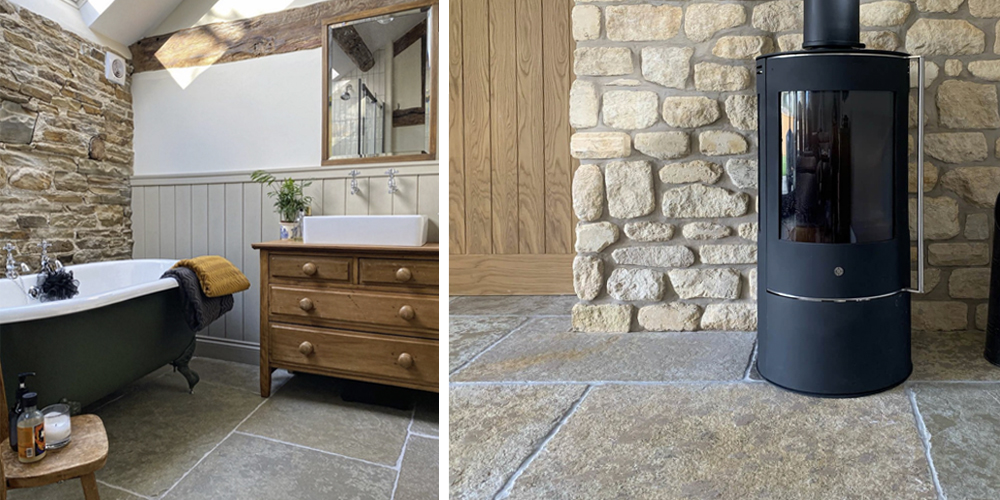Although porcelain continues to rank among the most popular flooring materials, there has been a real surge in the popularity of natural stone.
In the past, marble was seen as something only the wealthy could afford, and limestone was relatively unknown, as the only limestone tiles available were generally domestically quarried and very expensive. But nowadays, it’s an entirely different story!
In this article, we’re going to touch on what natural stone flooring is, its pros and cons, and the different types of finishes that can be applied to it, all so you can decide whether or not a new set of natural stone tiles are suitable to grace your home.
What is natural stone flooring?
As the name implies, natural stone flooring is a set of tiles made up of entirely natural stone that has been cut and refined to a set size, for use as a flooring material – it really is as simple as that!
Quarried from mines across the world, natural stone tiling is quickly becoming cheaper and easier to cut and refine for use as a construction material, and there are now numerous types of natural stone available for in-home tiling. Here at Stone Superstore, for example, our natural stone flooring types include:
- Limestone tiles
- Sandstone tiles
- Flagstones
- Marble tiles
Of course, there are many other stone options out there for you to pick from, with each providing similar benefits as each other.

Our Somerset Limestone tiles feature subtle, natural colour varitions and an antiqued finish, which looks beautiful in any setting.
What are the advantages and disadvantages of natural stone?
Much like porcelain tiles, there are a number of advantages and disadvantages that come with using all types of natural stone tile.
The benefits of natural stone
When it comes to the advantages of stone, homeowners can enjoy all of the following benefits:
- High and long-lasting durability.
- A natural and elegant look that is often one of a kind.
- A low-maintenance, easy-to-clean floor option.
The drawbacks of natural stone
However, natural stone also comes with the following disadvantages:
- It’s expensive, especially when laying down a large amount of tile.
- It needs to be sealed properly to avoid absorbing stains, a process which must be repeated every few years.
- It can chip if not looked after (if you do experience scuffing, read our guide to repairing scratched tiles).
- You may get a mismatched design due to the nature of how the stone is cut. However, all of your tiles should be from the same batch.
However, don’t let these disadvantages put you off. If installed correctly, you likely won’t have to worry about any of these downsides hugely.
What are the different types of natural stone tile finishes?
Unlike porcelain, opting to use natural stone in your home is usually a personal style choice. Generally speaking, people looking for natural stone in their house understand that every piece will be unique, as it's a natural material and deviations can occur.
However, while every piece of stone is different from each other, there is generally a uniformity in colour and pattern to these tiles which helps to form a consistent and elegant base style.
Some stone tiles also have a wide variety of colours in them that give a dramatic look, such as silver travertine, while others, like white limestone, are very uniform in colour. As a result, people typically base their buying decisions on a stone’s base colours, the amount of pattern found in the stone, and the surface finish.
Here at Stone Superstore, our natural stone tiles come in three main finishes:
- Polished: Polished stone tiles offer a high shine and is very reflective, typically being used for marble floors.
- Honed: Honed stone tiles are matt and usually have a silk-like appearance, making them a good middle ground between marble and limestone.
- Tumbled – this surface is given a worn and aged appearance and is exactly what you’d expect for a traditional limestone tile setup.
On top of these finishes, we also offer stylistic choices, like brushed or chiselled edges, both of which can also help to give the appearance of aged stone.

Our Ibiza Bianco Marble tiles come in both honed and polished finishes
Cleaning your natural stone tiles
Unlike many other materials used in construction, natural stone doesn't require a special cleaning regime. You’ll want to avoid bleach and coarse cleaning products, which can damage your tiles, but other than that, warm and soapy water is often enough to get the job done. Of course, for the best impact, we’d recommended using stone-specific cleaning products that won’t damage your tile or its seal.
And if you’re interested in learning more about caring for your flooring, read out guide: How to maintain stone tiles.
Resealing your stone tiles
One of the main considerations you’ll need to make when choosing natural stone flooring is the fact it requires protection with a sealant post-installation to avoid staining and dampness. This is also not a one-time process and will require you to reseal your tiles every couple of years.
However, re-sealing natural stone tiles is a very easy task and won't be required more than every two years, minimum.
You should now have a good idea of what to expect when browsing stone tiles for your home. Of course, if you do have any more questions, don’t hesitate to get in touch with our team of experts today, or browse our full collection of tile advice guides.
